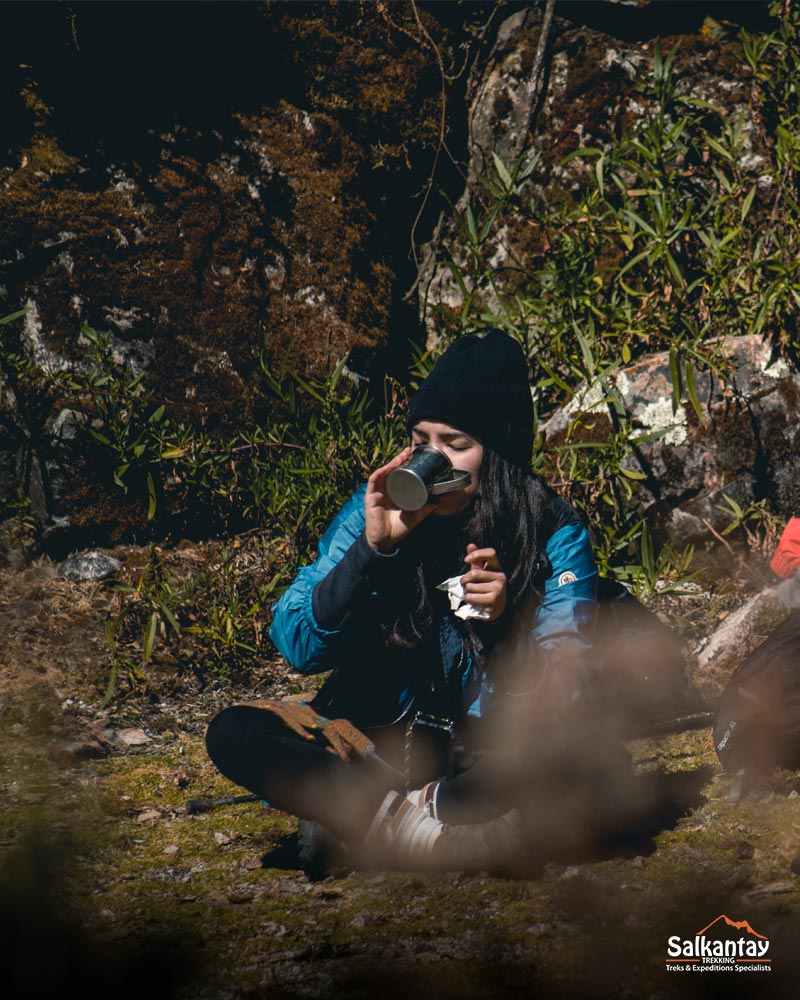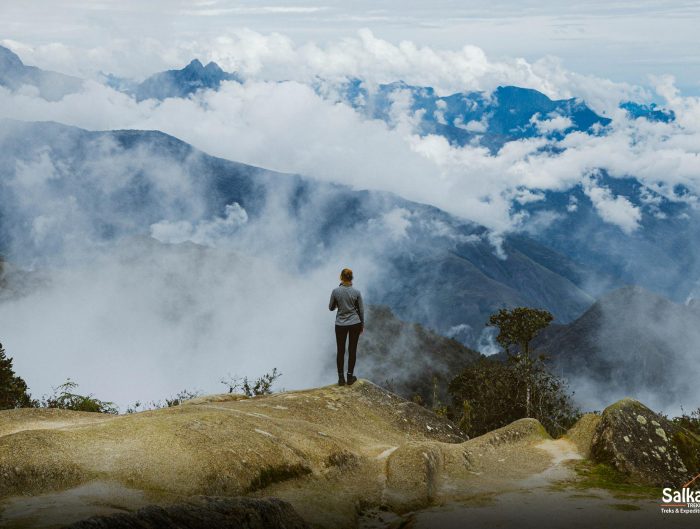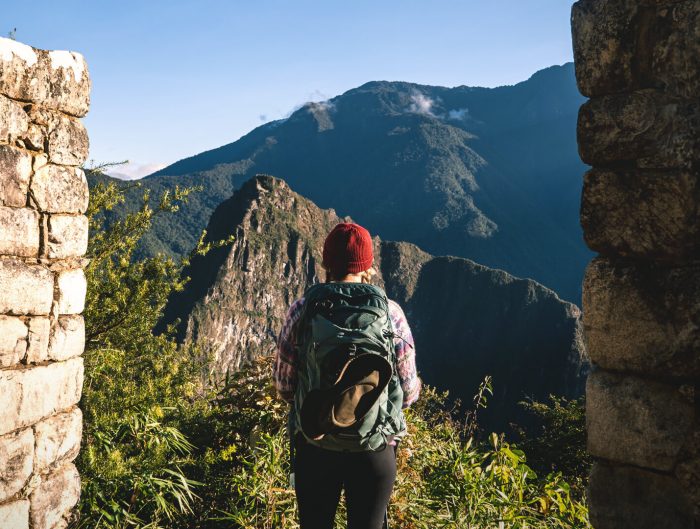Guide with Answers to Frequently Asked Questions.
The incredible Inca Trail is an ancestral journey that winds its way through the majestic mountains of the Peruvian Andes. It’s much more than just a hike; it’s a mystical experience, a dizzying blend of ancient history and wild nature. From the Inca ruins to the breathtaking panoramic views that leave you breathless, this trail is a mind-bending journey through time and space.

- What is the Inca Trail?
- Will I walk the entire trail?
- How difficult is the Inca Trail?
- Is acclimatization necessary for the Inca Trail?
- How to prepare physically?
- What level of physical fitness is required?
- How to eat on the Inca Trail?
- I’m already excited to do the Inca Trail! What else should I consider?
- You may also be interested in:
What is the Inca Trail?
The Inca Trail, also known as Qhapaq Ñan in Quechua, is an ancient network of trails built by the Incas in the Andean region of South America, specifically in the present-day countries of Peru, Ecuador, Bolivia, Chile, and Argentina. These trails connected vast regions of the Inca Empire and were used for various purposes, such as transporting people, goods, and messages, as well as for military and religious purposes.
Will I walk the entire trail?
No, only the most famous section of the Inca Trail, which leads to the citadel of Machu Picchu, located in the Peruvian Andes. This section starts in the Sacred Valley of the Incas, near the city of Cusco, and covers approximately 26.718 miles through mountains, valleys, and forests until reaching the majestic Inca citadel.
The Inca Trail to Machu Picchu is famous for its impressive landscape, rich history, and cultural significance. It’s one of the most popular trekking routes in the world and attracts thousands of visitors each year who seek to explore the ancient Inca trails and marvel at the panoramic views of the Andes.


How difficult is the Inca Trail?
Overall, the Inca Trail is not technically difficult in terms of climbing or specialized skills, but it requires good physical condition, proper preparation, and the ability to face the challenges associated with altitude and terrain. Many people of different ages and fitness levels successfully complete the Inca Trail each year. Some factors that influence difficulty include:
Altitude. The trek begins at a considerable altitude in Cusco, approximately 11154.632 feet above sea level, and reaches higher altitudes during the hike. Altitude can cause acclimatization problems and difficulty breathing, especially for those not accustomed to high altitudes.
Distance and terrain. The traditional Inca Trail is approximately 26.718 miles long and covers a variety of terrains, including steep sections, stone stairs, narrow paths, and variable weather conditions. The hike can last between 2 and 4 days, depending on the chosen route and walking pace.
Weather conditions. The weather in the Peruvian Andes can be unpredictable, with sudden changes in temperature, rain, and fog. This can affect the difficulty of the hike and the comfort of hikers.
Backpack weight. Carrying a heavy backpack with equipment and supplies can increase the difficulty of the hike, especially on steep and difficult terrain.


Is acclimatization necessary for the Inca Trail?
Yes, acclimatization is very important for the Inca Trail. Acclimatization allows your body to gradually adjust to the altitude and reduce the risk of altitude-related problems, such as altitude sickness or “soroche”.

It’s advisable to spend at least a couple of days in Cusco before starting the hike to allow your body to acclimatize to the altitude. During this time, it’s important to rest, stay well hydrated, avoid excessive alcohol and heavy foods, and avoid intense physical exertion.

Additionally, it’s advisable to take short and low-intensity hikes in the surroundings of Cusco during acclimatization to help your body gradually adapt to the altitude. This will help minimize the risk of experiencing negative effects of altitude during the trekking on the Inca Trail.

How to prepare physically?
While it’s true that the following recommendations are not mandatory, you can take into account these specific tips to prepare physically:
Cardiovascular training. Engage in cardiovascular activities such as running, swimming, cycling, or using an elliptical machine to improve your cardiovascular endurance. This will help you maintain a steady pace during long hikes and tackle uphill and downhill terrain.
Strength training. Incorporate strength exercises into your routine, such as weightlifting, full-body exercises with body weight, or resistance exercises with elastic bands. This will strengthen your muscles, which will help you carry a heavy backpack and tackle uneven terrain.
Leg training. Since much of the Inca Trail involves walking long distances, it’s important to strengthen your legs. Perform exercises such as squats, lunges, calf raises, and step-ups to strengthen the leg muscles and improve your endurance.
Balance and stability training. Because the terrain of the Inca Trail can be uneven and rocky, it’s helpful to improve your balance and stability. Perform exercises such as planks, side planks, and single-leg balances to improve your stability.


What level of physical fitness is required?
The Inca Trail is a challenging hike that requires a good level of physical fitness and endurance. Although you don’t need to be an elite athlete, it’s important to be prepared to face the challenges of the terrain, altitude, and duration of the hike. Here are the recommended physical requirements for successfully completing the Inca Trail:
Good cardiovascular condition. Good cardiovascular health is required to be able to walk long distances at a steady pace for several days.
Strength and muscular endurance. It’s necessary to have enough strength and muscular endurance in the legs, especially in the quadriceps, calves, and glutes, to be able to climb and descend stone stairs and walk on uneven terrain for long periods of time.
Flexibility. Adequate flexibility can help prevent muscle and joint injuries during trekking. Performing stretching exercises regularly can improve flexibility and joint mobility.
Positive mindset and determination. In addition to physical preparation, it’s important to have a positive mindset, determination, and willingness to overcome the challenges that may arise during the trekking.
By meeting these physical requirements and being well prepared both physically and mentally, you’ll be in a better position to successfully complete the challenging yet rewarding trekking on the Inca Trail to Machu Picchu.

How to eat on the Inca Trail?
Preparing your food before and during the Inca Trail is essential to maintain energy and endurance during the hike. Here are some guidelines:
Before the hike
Hydration. Start increasing your water intake several days before starting the hike to ensure you’re well hydrated. Avoid alcohol and caffeine drinks, as they can cause dehydration.
Carbohydrates. Consume a diet rich in complex carbohydrates, such as whole grains, rice, pasta, quinoa, and potatoes, to store glycogen in your muscles and provide energy during the hike.
Proteins. Include lean sources of protein, such as chicken, turkey, fish, tofu, legumes, and eggs, to help repair and strengthen muscles during the pre-hike training period.
Healthy fats. Incorporate healthy fats into your diet, such as avocado, nuts, seeds, and olive oil, to provide extra energy and help maintain a feeling of satiety.
Nutritious snacks. Pack healthy and nutritious snacks to take with you during the hike, such as fresh fruits, nuts, granola bars, whole grain cookies, and dark chocolate.


During the hike
Constant hydration. Drink water regularly during the hike to stay hydrated and offset the loss of fluids caused by exercise and altitude.
Energetic snacks. Consume energizing and quickly digestible snacks to replenish carbohydrates and maintain your energy levels, such as energy bars, dried fruits, whole grain cookies, and sports drinks.
Balanced meals. Opt for balanced and nutritious meals at lunch and dinner stops, which include a combination of carbohydrates, proteins, and healthy fats to replenish lost nutrients and regain energy.
Avoid heavy foods. Avoid heavy and greasy meals that can hinder digestion and cause stomach discomfort during the hike.
Optional supplements. Consider taking optional supplements such as energy gels, electrolyte tablets, or oral rehydration salts to help maintain electrolyte balance and prevent dehydration.
By following these nutritional guidelines before and during the Inca Trail, you’ll be able to maintain your energy levels, improve your performance, and enjoy a more comfortable and satisfying experience during trekking.

I’m already excited to do the Inca Trail! What else should I consider?
We offer you a list of tips to keep in mind:
Book in advance. The Inca Trail has a limited quota of visitors per day, so make sure to book your space well in advance through an authorized agency.
Proper equipment. Make sure to wear appropriate clothing and footwear for walking in different weather conditions. Don’t forget to pack a comfortable and lightweight backpack with essentials such as water, sunscreen, insect repellent, and a first aid kit.
Respect the environment. The Inca Trail is a protected archaeological and natural site, so make sure to follow the rules and regulations established to preserve its beauty and conservation.
Enjoy the journey. The Inca Trail is a unique and unforgettable experience. Take the time to enjoy the scenery, learn about Inca culture, and connect with nature as you venture to Machu Picchu. The idea is not to go fast but to enjoy every little step.
Choose a reliable agency. If you decide to do the trek with an agency, choose one that is reliable and has experience in organizing trips to the Inca Trail. Make sure they offer quality services and respect safety and sustainability standards.


By following these tips and preparing properly, you’ll be better equipped to successfully complete the challenging yet rewarding Inca Trail to Machu Picchu. Get ready to immerse yourself in a journey on the edge of reality, where the boundaries between the tangible and the intangible blur. The Inca Trail awaits you, with its mysteries to unravel and its landscapes to conquer.
You may also be interested in:
- Exploring the Charms of the Inca Trail: A Memorable Experience
- Best Environmental Practices on the Inca Trail
- A Trip Through Time to the Archaeological Sites of the Inca Trail
- What to Wear for The Inca Trail 2024?
- INCA TRAIL 2024: The New Porter Law
- PLAYLIST: Inca Trail 2024
- Everything you Need to Know About the Inca Trail in 2024
- Essential Tips for Your Inca Trail Trek to Machu Picchu
- Why You Need to Book Your Inca Trail Hike Right Now
- A Complete Hiker’s Handbook for Peru’s Inca Trail
- Essential Information for the Inca Trail
- Inca Trail: Essential Gear for an Unforgettable Adventure














Leave A Reply